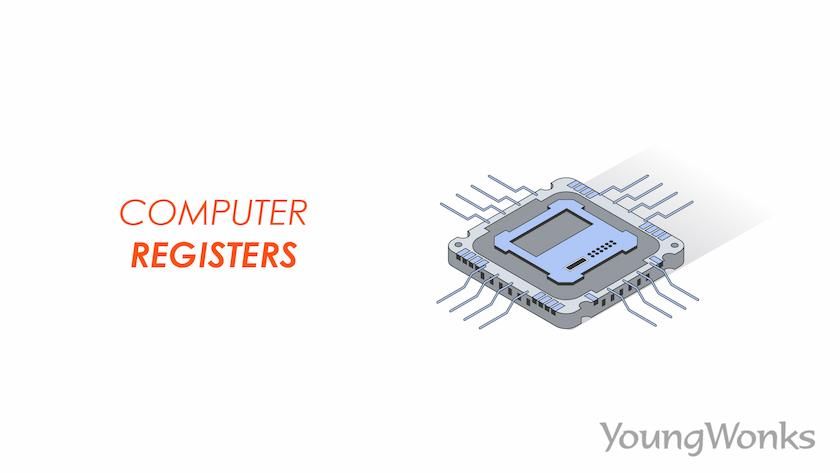Sep 05, 2024 By Team YoungWonks *
Computer Registers: A Comprehensive Guide
Imagine trying to read a book, but every time you turn a page, you have to fetch it from a library miles away. Sounds slow and frustrating, right? That’s exactly what would happen if a computer processor had to retrieve every piece of data directly from RAM or a hard drive. This is where computer registers come in—acting like a small, ultra-fast notepad inside the CPU, where crucial data, instructions, and memory addresses are stored temporarily for quick access.
Registers are the fastest memory units in a computer system, designed to handle critical operations at lightning speed. They exist within the central processing unit (CPU) and ensure that the system runs efficiently by minimizing delays caused by frequent access to main memory. Whether it’s executing arithmetic operations, processing instructions, or handling intermediate results, registers play a key role in maintaining the CPU’s smooth workflow.
In computer architecture, registers help streamline processing by keeping frequently used data close to the processor, significantly reducing execution time. Unlike cache memory or RAM, which still require some level of lookup, registers work directly at the processor's clock speed, ensuring instant data retrieval and storage. They are fundamental in the execution of programs, acting as the bridge between memory and the Arithmetic Logic Unit (ALU), where mathematical and logical operations take place.
For software developers, programmers, and system designers, understanding registers is vital for performance optimization, addressing modes, and efficient algorithm execution. Registers influence how compilers optimize code, how the CPU prioritizes operations, and how instructions are executed within a microprocessor. Different types of registers—such as general purpose registers, control registers, and data registers—each serve specific roles in enhancing the efficiency of a computer system.
Beyond just raw speed, registers also impact instruction execution cycles. Every program you run, from a simple calculator app to complex artificial intelligence models, relies on registers to fetch, decode, and execute instructions efficiently. These registers store values such as the address of the next instruction, operands, intermediate results, and control signals to ensure that the CPU works seamlessly.
To put things into perspective, think of registers as high-speed assistants for the processor. While main memory (RAM) can be compared to a large filing cabinet where all data is stored, registers act as sticky notes on the CPU’s desk—holding only the most critical and immediately needed data. The more efficiently these registers are used, the faster and smoother the entire system runs.
What Are Computer Registers?
A computer register is a fast, volatile memory location inside a processor. It temporarily holds operands, instruction addresses, data values, and intermediate results required for processing.
Unlike main memory (RAM), registers are directly controlled by the CPU and operate at processor clock speed, significantly reducing execution time. Registers are categorized based on their function, such as storing instructions, data, memory locations, or temporary values.
Why Are Registers Important?
- Speed: Registers are faster than cache memory and RAM, allowing quick data retrieval.
- Reduced Memory Access: Registers minimize the need for frequent access to computer memory, improving efficiency.
- Essential for Computation: Registers facilitate arithmetic operations, logic processing, and control flow.
- Instruction Execution: Registers help in fetching, decoding, and executing instructions efficiently.
For an overview of computer memory hierarchy, refer to IBM’s technical guide.
Types of Registers in a CPU
Registers can be classified into different categories based on their roles within the microprocessor.
1. General-Purpose Registers (GPRs)
These registers store temporary data and operands during execution. They are widely used for arithmetic operations, logical computations, and data movement.
Examples in Intel Architecture:
- AX (Accumulator Register) – Stores intermediate results of arithmetic and logic operations.
- BX (Base Register) – Holds memory addresses for data storage.
- CX (Counter Register) – Used for loop counters and iteration.
- DX (Data Register) – Assists in I/O operations and extended arithmetic calculations.
Modern processors have 64-bit general-purpose registers (e.g., RAX, RBX, RCX, and RDX) for enhanced processing.
Read more about processor registers at Intel’s official documentation.
2. Control Registers
Control registers manage CPU operations, including enabling/disabling execution modes and managing interrupts.
Key Control Registers:
- Program Counter (PC): Holds the address of the next instruction.
- Instruction Register (IR): Stores the current instruction being executed.
- Status Register (FLAGS Register): Maintains condition flags (e.g., Zero Flag, Carry Flag, Sign Flag).
For an in-depth guide on control registers, visit OSDev.
3. Address Registers
These registers store memory locations for fetching and storing data.
Important Address Registers:
- Memory Address Register (MAR): Holds the memory location of data or instructions to be fetched.
- Index Register: Used for addressing modes like indexed addressing, enabling dynamic memory access.
4. Data Registers
Data registers store values used in computations and memory transfers.
Examples:
- Memory Data Register (MDR): Temporarily holds data read from or written to memory.
- Accumulator Register: Stores intermediate results of arithmetic and logical computations.
For more details, visit Studytonight.
5. Stack Pointer and Buffer Registers
- Stack Pointer (SP): Tracks the top of the stack memory, critical for function calls and recursion.
- Memory Buffer Register (MBR): Holds temporary data before moving it to memory.
How Registers Work in a Computer System
The fetch-decode-execute cycle explains how registers function during program execution.
1. Fetch Phase
- The Program Counter (PC) sends the address of the next instruction to the Memory Address Register (MAR).
- The instruction is fetched from main memory and stored in the Memory Data Register (MDR).
2. Decode Phase
- The instruction moves to the Instruction Register (IR), where the Control Unit (CU) interprets it.
- The instruction’s operands and addressing modes are identified.
3. Execute Phase
- The Arithmetic Logic Unit (ALU) performs calculations using General-Purpose Registers.
- The Accumulator Register holds intermediate results.
4. Store Phase
- The computed result is stored in a register or memory location.
For more details on CPU execution cycles, check Carnegie Mellon’s CS course.
Registers in Different CPU Architectures
1. Intel CPU Registers
Intel processors support 16, 32, and 64-bit registers, including special-purpose and segment registers for memory management.
2. ARM Architecture
ARM processors use R0 to R15 registers, optimized for low-power, high-performance applications.
3. RISC vs. CISC Registers
- RISC (Reduced Instruction Set Computing): Uses more registers, allowing simpler and faster execution.
- CISC (Complex Instruction Set Computing): Uses fewer registers but executes more complex instructions per cycle.
For further reading, visit ARM’s official documentation.
Programming with Registers
1. Assembly Language and Registers
Low-level programming languages like Assembly directly access registers.
Example in x86 Assembly:
- MOV AX, 5 ; Store 5 in AX register
- ADD AX, 2 ; Add 2 to AX
- MOV BX, AX ; Copy result to BX
2. Registers in High-Level Languages (Python, Java, PHP)
High-level languages like Python, Java, and PHP do not provide direct access to registers, but compilers optimize their use internally.
Example in Python (loop counter stored in a register for fast execution):
for i in range(10):
print(i)
Understanding Data Storage and Specialized Registers in Computer Science
Registers play a fundamental role in computer science, particularly in how computers store data, process instructions, and manage input/output operations. Unlike RAM or secondary storage, registers provide ultra-fast access to essential information, ensuring smooth execution of programs. Specialized registers are designed to handle specific tasks, improving the efficiency of data processing and computation within the CPU.
1. Storing Data in Registers
Registers are used to store data temporarily during instruction execution. The CPU fetches data from main memory, processes it, and then stores intermediate results in registers. This reduces the need for frequent memory accesses, enhancing overall system performance. The size of a register, typically measured in number of bits, determines how much data it can hold at a time. Common register sizes include 8-bit, 16-bit, 32-bit, and 64-bit, depending on the CPU architecture.
2. Input and Output Registers
- Input Register: This register is responsible for temporarily holding data received from input devices such as a keyboard, mouse, or sensors before it is processed by the CPU. It ensures that incoming data is available for immediate use.
- Output Register: This register stores processed data before sending it to an output device, such as a monitor or printer. It acts as a buffer between the CPU and external devices, ensuring smooth data transmission.
3. Temporary and Shift Registers
- Temporary Register: As the name suggests, this register holds data temporarily while the CPU executes an instruction. It is used primarily for storing intermediate results during complex operations, ensuring that calculations proceed smoothly without needing frequent memory access.
- Shift Register: This register is designed to shift data bits left or right within the register. It is commonly used in data manipulation, encryption, and serial-to-parallel data conversion. Shift registers are vital in digital circuits for tasks like bitwise operations and signal processing.
4. Flip-Flops and Their Role in Registers
At the core of register design are flip-flops, which are binary storage elements that hold a single bit of data (0 or 1). Multiple flip-flops are combined to form registers, allowing them to store multi-bit values. Flip-flops play a crucial role in ensuring that data remains stable within registers while being processed. Different types of flip-flops, such as D-flip-flops, T-flip-flops, and JK-flip-flops, are used in designing registers depending on the required functionality.
5. Increment Operations and CPU Performance
Registers are also responsible for increment operations, which are widely used in programming and system design. For example, the program counter (PC) register automatically increments to point to the address of the next instruction during program execution. This ensures a smooth and continuous flow of operations, reducing the need for manual memory addressing. Similarly, index registers support incremental addressing modes, making them essential in loop execution and array processing.
Conclusion
Computer registers are essential for fast data processing, efficient instruction execution, and seamless memory access. They serve as the high-speed storage units within the CPU, minimizing delays by keeping frequently accessed data close to the processor. Whether storing operands, memory addresses, or intermediate results, registers ensure that computation happens at the fastest possible speed, significantly improving system performance.
Understanding registers is fundamental for anyone studying computer architecture, microprocessors, and system design. Their impact extends beyond hardware, influencing programming efficiency, compiler optimizations, and algorithm performance. Even in high-level languages like Python, Java, and PHP, registers work behind the scenes to speed up execution.
As computing technology advances, the efficient use of registers remains a key factor in CPU performance and power efficiency. Whether in traditional CISC architectures like Intel’s x86 or modern RISC-based ARM processors, registers continue to play a vital role. A strong grasp of their functionality can help developers and engineers optimize software execution, hardware design, and overall system efficiency.
*Contributors: Written by Kabir Pandey; Edited by Disha N; Lead image by Shivendra Singh

